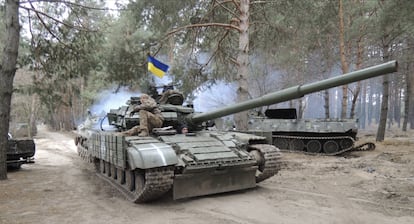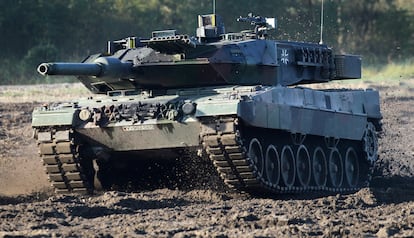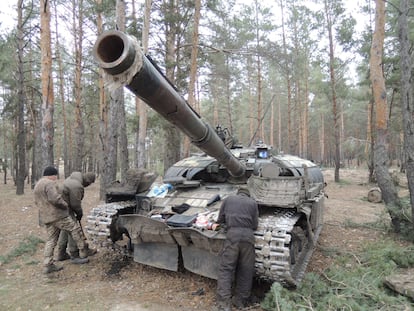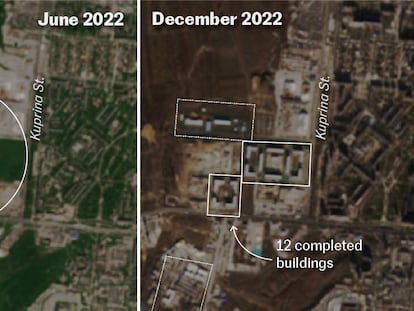NATO tanks will be key to Ukraine’s latest offensive
Ukrainian officers and soldiers on the eastern front say it is impossible to liberate more Russian-occupied territory without German Leopards and American Abrams


Driving a German Leopard 2 third-generation battle tank is Viktor Syabrenko’s dream. For the time being, he has had to make do with a lesser vehicle. Smiling gleefully, he poses in front of the tank that he has been operating since the beginning of the invasion of Ukraine: a Soviet-era T-72.
“We’ve covered 2,000 miles together since the start of the invasion [on February 24, 2022], from Kyiv to here,” says Syabrenko, who is resting at a temporary base. Ukraine’s 3rd Tank Brigade is stationed in a village between the provinces of Kharkiv and Luhansk. The Russian positions are less than 10 miles east.
The vehicles of the 3rd Brigade sit in now-empty rural areas. Fields of corn and sunflowers remain unharvested, with their crops blackened and crushed under the tracks of the tanks. Despite the emotional attachment he has to his T-72, Syabrenko says that he would trade it for a German Leopard 2 in a second.
The United States and several European members of NATO have opened a new chapter in the supply of weapons to Ukraine: armored vehicles. Since December 2022, commitments have been made to send light-armored combat vehicles to the embattled country. Washington will be supplying 50 Bradley fighting vehicles; Germany will send 40 Marder vehicles, while France will deliver even more powerful AMX-10 reconnaissance vehicles.
Despite all of this support, for Ukraine to launch a new offensive – one that will allow it to regain lost territory – it needs tanks. Officers from the 3rd Armored Brigade and the 92nd Mechanized Brigade tell EL PAÍS that, without tanks, there will be no way to advance beyond the front lines in Kharkiv.
The two tanks the Kyiv government desperately wants are the German Leopards and US-produced Abrams. Military experts say that the best option – for geographical reasons – is the Leopard, because it’s the most common heavy armored vehicle in continental Europe, with 2,000 units available, according to data from the Financial Times. The problem is, for these vehicles to be exported, the countries that currently have many in their possession – such as Poland and Finland, who are eager to supply them as quickly as possible – require the approval of Berlin. This was part of the contract of sale, as the tanks are produced in Germany.
Olaf Scholz’s government has, so far, been hesitant to approve this move. Berlin fears that sending heavy tanks into Ukraine will increase tensions with Russia. However, Chancellor Scholz says that he will acquiesce to President Zelenskiy’s request should the United States do the same with its Abrams. Meanwhile, UK Prime Minister Rishi Sunak announced last weekend that his government will be shipping Challenger 2 tanks to Kyiv.

Valerii Zaluzhnyi – commander-in-chief of the Ukrainian Armed Forces – indicated last December that, for his troops to be able to reconquer the territory lost since February 24, they require 300 tanks, 700 armored infantry vehicles and 500 artillery pieces from NATO.
Ukraine had 900 tanks at the start of the Russian invasion, according to RUSI, a British institute for military studies. Russian armored strength stood at 3,200 vehicles. After nearly 10 months of fighting, Ukraine has lost about 500 tanks, while Russia has lost 1,500.
The command center of the 3rd Tank Brigade has been established on a modest farm. Officers, transmission equipment, maps, computers and food reserves are stuffed into the cramped quarters. Outside, the temperature drops below freezing – wood-burning stoves are kept fed at all times.
Alkut is the codename of the colonel who is one of the commanders at the 3rd Brigade. A veteran of the 2014 war in Donbas, he also served in Iraq and Afghanistan, in Ukrainian battalions that supported the US-led coalition. Alkut trained in the 1970s as a tankman at a Soviet academy.
When asked why the German and American tanks are better than the Soviet-era ones, he replies: “The USSR didn’t prioritize quality, but quantity. Western countries were always modernizing their tanks, unlike the Soviets.”
Since the defeats Moscow suffered last September and October on the Kharkiv and Kherson fronts, the invading army has had time to fortify its defensive positions. Alkut lists several advantages of the Leopard and Abrams tanks, which would help the Ukrainians break the lines on the Luhansk front: they have better armor, maneuverability and engine power, bolstering the safety of both the soldiers who operate them and the infantry columns that trail behind during an attack. The ergonomics of these tanks are incomparably better than Soviet tanks – decisive in battles lasting many hours. They have night vision scopes and technology that calculates the movements of enemy targets, to fire with greater precision.

Andrei Krivonos – commander of a T-72 from the 3rd Tank Brigade – explains that his tanks are useless against modern Russian armored vehicles such as the T-80 BVM or the T-64 BV, which have night vision and latest-generation engines, comparable to the Abrams tanks.
“When we capture one, we celebrate,” Krivonos chuckles. His superior, Alkut, estimates that one Abrams is equivalent in attack power to two or three Soviet tanks.
At the Warsaw Security Forum in October 2022, three of NATO’s most important generals were in attendance. Mark Carleton-Smith – the UK army chief-of-staff until last year – made a plea for armies with fewer tanks, but with fully-developed technological capacity. The trend until the war in Ukraine, according to Carleton-Smith, had been to reduce investment in tanks in favor of drones and mobile anti-aircraft defenses.
“But the Ukrainians tell us that the tanks are essential… and they’re the ones who are actually fighting the Russians,” the British general admitted.
Dvorkin, a Ukrainian sergeant, is a company commander of 10 T-64s from the 92nd Mechanized Brigade. Under a pine forest near the front – with Russian artillery pounding nearby – dozens of tanks are hidden, most of them undergoing maintenance.
“All our machines are in poor condition,” Dvorkin sighs, showing EL PAÍS the tracks of the tanks, which are visibly worn. Some of the vehicles’ submachine guns can only fire half magazines, he adds. “These weapons have been used in combat since 2014.”
The main involuntary supplier of armored vehicles to Ukraine has been Russia. Since the end of March – when the Kremlin’s troops began to retreat from Kyiv and its neighboring provinces – the Ukrainian Armed Forces have reportedly captured nearly 500 Russian tanks, in addition to other vehicles and weapons.
Andrii is a 32-year-old lieutenant. He leads a platoon fighting with a T-64 from Dvorkin’s company. Last Thursday, his mission was to try to repair a T-72, obtained as a war trophy from the Russians. “Only between 10% and 20% of the tanks that the Russians leave us can be used again for combat… they’re in very bad condition. The Soviet [era] machinery is very poor.”
Colonel Alkut estimates that one in three tanks abandoned by the Russians is being used by the Ukrainian Armed Forces; the rest are scrapped, so that their parts may be used to repair other vehicles.

Russian tanks have been dropping like flies. One reason for this, according to Lieutenant Andrii, is the effectiveness of the Ukrainian fire: “We, on average, need three shots to destroy a target; Russian units, on the other hand, fire randomly, no matter how much ammunition they waste. We’re also more efficient in the use of drones, which give us the coordinates that we need to hit.”
Dvorkin also points out that Russian anti-tank rockets are far less destructive when compared to the anti-tank weapons that Ukraine has received from NATO. Dvorkin and Alkut note that they have tanks that have been hit by up to three Soviet RPG missiles, yet the vehicles have continued to fight. If they had NATO-provided tanks, the damage would be even less impactful.
“A new offensive isn’t possible without receiving Western tanks,” concludes Dvorkin. The Ukrainians wish to restart attacks during the winter, when the ground is frozen and the tanks can roll better. In spring, rain and rising temperatures turn the countryside into a muddy nightmare, through which armored vehicles can no longer advance.
With his hands still on the Russian T-72 that he and his men are trying to repair, Andrii tells EL PAÍS that he can easily handle a new tank. “Before February 24, I had no military experience – I worked in sales. In 40 days, I was trained to drive a tank. Now, here I am, standing up to the Russians. Why can’t I do it again with a Leopard?”
Sign up for our weekly newsletter to get more English-language news coverage from EL PAÍS USA Edition
Tu suscripción se está usando en otro dispositivo
¿Quieres añadir otro usuario a tu suscripción?
Si continúas leyendo en este dispositivo, no se podrá leer en el otro.
FlechaTu suscripción se está usando en otro dispositivo y solo puedes acceder a EL PAÍS desde un dispositivo a la vez.
Si quieres compartir tu cuenta, cambia tu suscripción a la modalidad Premium, así podrás añadir otro usuario. Cada uno accederá con su propia cuenta de email, lo que os permitirá personalizar vuestra experiencia en EL PAÍS.
¿Tienes una suscripción de empresa? Accede aquí para contratar más cuentas.
En el caso de no saber quién está usando tu cuenta, te recomendamos cambiar tu contraseña aquí.
Si decides continuar compartiendo tu cuenta, este mensaje se mostrará en tu dispositivo y en el de la otra persona que está usando tu cuenta de forma indefinida, afectando a tu experiencia de lectura. Puedes consultar aquí los términos y condiciones de la suscripción digital.
More information
Archived In
Últimas noticias
The complicated life of Francesca Albanese: A rising figure in Italy but barred from every bank by Trump’s sanctions
Half of Scotland is in the hands of 420 property owners
Pinochet’s victims grapple with José Antonio Kast’s rise in Chile
Reinhard Genzel, Nobel laureate in physics: ‘One-minute videos will never give you the truth’
Most viewed
- Pablo Escobar’s hippos: A serious environmental problem, 40 years on
- Why we lost the habit of sleeping in two segments and how that changed our sense of time
- Charles Dubouloz, mountaineering star, retires at 36 with a farewell tour inspired by Walter Bonatti
- Reinhard Genzel, Nobel laureate in physics: ‘One-minute videos will never give you the truth’
- The Florida Keys tourist paradise is besieged by immigration agents: ‘We’ve never seen anything like this’









































